For centuries, people have worn Catholic jewelry and patron saint medals as a way to show their devotion to their faith and to seek the intercession of their patron saints. These items are more than just accessories; they are symbols of the wearer’s relationship with God and the saints.
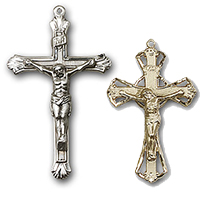 One of the main reasons Catholics wear religious jewelry is to express their faith. In this article by the CatholicShop.com jewelry experts, we explore the reasons why people wear Catholic jewelry and patron saint medals, with a special focus on some of the most popular types of religious jewelry.
One of the main reasons Catholics wear religious jewelry is to express their faith. In this article by the CatholicShop.com jewelry experts, we explore the reasons why people wear Catholic jewelry and patron saint medals, with a special focus on some of the most popular types of religious jewelry.
The Cross and Crucifix: A Daily Reminder of God’ Love
Many Catholics wear a crucifix or a cross as a reminder of the sacrifice that Jesus Christ made for humanity.
The crucifix is a powerful symbol that represents the suffering and death of Jesus on the cross. It serves as a reminder of the love that Jesus has for all people and the importance of self-sacrifice. See our crucifixes and crosses.
Patron Saint Medals: A Saint For Every Soul
It’s no secret that patron saint medals are another common form of Catholic jewelry. Each patron saint is associated with a specific area of life, such as health, work, or relationships.
 By wearing a patron saint medal, people are often asking for the saint’s intercession in their lives. For example, someone who is struggling with health issues may wear a St. Jude medal, while someone who is looking for a job may wear a St. Joseph medal.
By wearing a patron saint medal, people are often asking for the saint’s intercession in their lives. For example, someone who is struggling with health issues may wear a St. Jude medal, while someone who is looking for a job may wear a St. Joseph medal.
Others may wear a patron saint medal in association with their favorite saint, a Sacramental connection, or, in some cases, when someone is named after a particular saint.
Catholic jewelry and patron saint medals can also serve as a source of comfort and protection. Many people believe that wearing a patron saint medal can offer protection from harm and evil. The medal serves as a reminder that the saint is watching over them and offering guidance and protection.
Catholic Shop offers thousands of different patron saint medals in Sterling Silver, 14K Gold, and other metals. Most of these saint medals can be engraved for a small extra charge, making them very special gifts for loved ones. See our patron saint medals.
Miraculous Medals: The Most Popular Catholic Jewelry
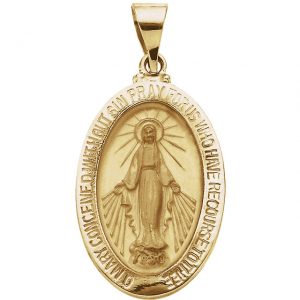 The Miraculous Medal, also known as the Medal of the Immaculate Conception, is a popular devotional item among Catholics. It features the image of the Blessed Virgin Mary on the front and the letter “M” intertwined with a cross and the Sacred Heart of Jesus on the back. Catholic people wear the Miraculous Medal as a sign of their devotion to the Virgin Mary and their faith in God’s grace and protection.
The Miraculous Medal, also known as the Medal of the Immaculate Conception, is a popular devotional item among Catholics. It features the image of the Blessed Virgin Mary on the front and the letter “M” intertwined with a cross and the Sacred Heart of Jesus on the back. Catholic people wear the Miraculous Medal as a sign of their devotion to the Virgin Mary and their faith in God’s grace and protection.
The Miraculous Medal originated in 1830 through Saint Catherine Labouré, a novice in the Daughters of Charity of Saint Vincent de Paul in Paris. The Virgin Mary appeared to Catherine in a vision and asked her to create a medal with her image on it. The Virgin Mary promised that all who wore the medal with faith would receive her special protection and graces.
Since then, the Miraculous Medal has become a widespread and beloved devotion among Catholics around the world. Many Catholics believe that wearing the Miraculous Medal can bring them spiritual benefits, including protection from harm, physical healing, and spiritual graces. They also see it as a way to express their love and devotion to the Virgin Mary, who is considered to be the Mother of God and the patroness of all humanity.
Wearing the Miraculous Medal is not only a personal expression of faith but also a visible sign of belonging to a larger community of believers. By wearing the medal, Catholics identify themselves as members of the Church and as followers of Christ. It is a way to connect with other Catholics and to share their faith with others.
The Miraculous Medal is also a reminder of the Catholic teachings on the role of Mary in the Church and in the life of believers. The medal’s design and wording convey that Mary was chosen by God to be the Mother of Jesus and that she continues to intercede for us before God. Catholics see Mary as a model of faith, obedience, and love, and wearing the Miraculous Medal is a way to honor her and seek her help in our spiritual journey.
In short, Catholics wear the Miraculous Medal for many reasons, especially as a sign of their devotion to the Virgin Mary and their faith in God’s protection and grace. It is a personal expression of faith, a visible sign of belonging to a larger community of believers, and a reminder of the Catholic teachings on the role of Mary in the Church and in the life of believers.
For many Catholics, the Miraculous Medal is a source of comfort, hope, and spiritual strength, and it continues to inspire and transform the lives of believers around the world. Learn more in our related article 20 Secrets of the Miraculous Medal, and shop our many varieties of Miraculous Medals.
St. Benedict Medals: Ancient Protection
The St. Benedict Medal is one of the most widely recognized and venerated devotional medals in the Catholic Church. Its origins can be traced back to the life and legacy of St. Benedict, a 6th-century monk who founded the Benedictine order and played a key role in shaping the Christian monastic tradition.
The St. Benedict Medal was first struck in 1880 to commemorate the 1,400th anniversary of the birth of St. Benedict. However, the design of the medal itself goes back much further.
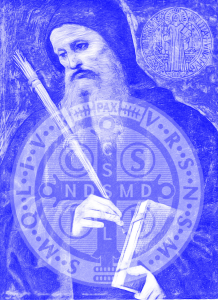 According to tradition, St. Benedict himself had a vision in which he saw the image of a cross with the letters “CSPB” inscribed above it, and the letters “CSSML” inscribed below it. These letters stand for the Latin phrases “Crux Sancti Patris Benedicti” (“The Cross of the Holy Father Benedict”) and “Crux Sacra Sit Mihi Lux” (“May the Holy Cross be my light”).
According to tradition, St. Benedict himself had a vision in which he saw the image of a cross with the letters “CSPB” inscribed above it, and the letters “CSSML” inscribed below it. These letters stand for the Latin phrases “Crux Sancti Patris Benedicti” (“The Cross of the Holy Father Benedict”) and “Crux Sacra Sit Mihi Lux” (“May the Holy Cross be my light”).
St. Benedict’s vision also included an image of a raven carrying a loaf of bread, a reference to a miracle attributed to St. Benedict in which a raven brought him food during a period of extreme fasting.
The design of the St. Benedict Medal features these elements as well as other symbols associated with St. Benedict and his life. The front of the medal shows the image of St. Benedict holding a cross and a book, with a raven nearby. The back of the medal features a cross with the letters and phrases mentioned earlier, as well as the letters “PAX” (“Peace”), which was a central theme in St. Benedict’s teachings.
Priests in the Catholic Church often recommend the use of St. Benedict Medals as a means of spiritual protection and intercession. The medal is believed to have the power to ward off evil, protect against spiritual attacks, and promote spiritual growth and well-being. Many priests and religious orders distribute St. Benedict Medals as a form of blessing and protection for those in their care.
The use of the St. Benedict Medal is also associated with the practice of exorcism in the Catholic Church. During an exorcism, a priest may pray with or place a St. Benedict Medal on the person being exorcised as a means of warding off demonic influence.
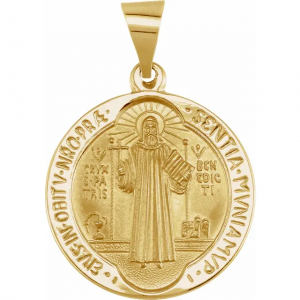 Catholic people often wear St. Benedict Medals as a visible sign of their faith and devotion. The medal serves as a reminder of the spiritual protection and intercession available to them through the intercession of St. Benedict and his teachings. Many people also wear the medal as a form of “spiritual armor,” a form of personal protection against the various trials and tribulations of life.
Catholic people often wear St. Benedict Medals as a visible sign of their faith and devotion. The medal serves as a reminder of the spiritual protection and intercession available to them through the intercession of St. Benedict and his teachings. Many people also wear the medal as a form of “spiritual armor,” a form of personal protection against the various trials and tribulations of life.
Additionally, the St. Benedict Medal is often used as a tool for prayer and meditation. Many people carry the medal with them as a tangible reminder to pray and seek the intercession of St. Benedict in their daily lives.
In conclusion, the St. Benedict Medal is a powerful symbol of the Christian faith and the legacy of St. Benedict. Its origins date back centuries, and its design incorporates many elements associated with St. Benedict and his teachings. The St. Benedict Medal continues to be a cherished and revered symbol of the Catholic Church and its rich history and traditions. See our popular line of St. Benedict medals.
Are Rosaries Considered Jewelry?
 Another popular item is the rosary, although most Catholics do not consider it as a form of jewelry and it was not intended to be worn. With that said, some believers wear their rosary to display their faith or to always keep it close for prayer.
Another popular item is the rosary, although most Catholics do not consider it as a form of jewelry and it was not intended to be worn. With that said, some believers wear their rosary to display their faith or to always keep it close for prayer.
The rosary is a powerful prayer tool that can aid in meditation on the life of Jesus and the mysteries of the faith. On a basic level, the rosary is a set of prayer beads that are used to recite prayers in a specific order. The prayers are focused on the life, death, and resurrection of Jesus Christ, and the repetition of the prayers helps to create a meditative state. Keeping a rosary on hand can be a reminder to pray and to stay focused on God throughout the day. See our immense rosary selection.
The origins of the rosary can be traced back to the early days of Christianity, where monks and hermits would recite a specific number of prayers on a string of knots or beads. However, the modern form of the rosary that is widely used today dates back to the Middle Ages when it was developed by St. Dominic, a Spanish priest. St. Dominic is said to have received the rosary from the Virgin Mary herself, who instructed him to use it as a tool for evangelization and a means of spreading the Gospel.
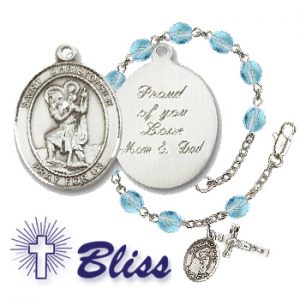 The rosary became particularly popular in the 16th century after the Battle of Lepanto, where the Christian fleet defeated the Ottoman Turks. Pope Pius V attributed the victory to the intercession of the Blessed Virgin Mary, who had been invoked through the rosary, and he subsequently established the feast of Our Lady of the Rosary. Since then, the rosary has been an integral part of Catholic tradition.
The rosary became particularly popular in the 16th century after the Battle of Lepanto, where the Christian fleet defeated the Ottoman Turks. Pope Pius V attributed the victory to the intercession of the Blessed Virgin Mary, who had been invoked through the rosary, and he subsequently established the feast of Our Lady of the Rosary. Since then, the rosary has been an integral part of Catholic tradition.
Although rosaries are beloved by many faithful, the use of a rosary is a personal choice for Catholics and is not required by the Church. Opinions about wearing a rosary often differ, but the consensus seems to be that Catholics may choose to do so as a visible sign of their faith and devotion to the Blessed Virgin Mary.
 However, it is important to remember that the rosary is not a piece of jewelry or a fashion accessory. Catholics should not wear a rosary solely for its aesthetic value or to show off their faith. Additionally, if wearing a rosary causes it to be damaged or disrespected, it is better not to wear it at all. Ultimately, the decision to wear a rosary should be guided by a sincere devotion to Mary and a desire to grow in faith and holiness.
However, it is important to remember that the rosary is not a piece of jewelry or a fashion accessory. Catholics should not wear a rosary solely for its aesthetic value or to show off their faith. Additionally, if wearing a rosary causes it to be damaged or disrespected, it is better not to wear it at all. Ultimately, the decision to wear a rosary should be guided by a sincere devotion to Mary and a desire to grow in faith and holiness.
Rosary bracelets, however, are intended to be worn in the same way one would wear jewelry. Keeping a rosary bracelet around the wrist encourages frequent prayer. See our many beautiful variations of the rosary bracelet.
Similary, the rosary ring is intended to be worn like jewelry and it also encourages prayer throughout the day. Small raised beads on these rings act as rosary beads. Catholic Shop designed a unique spinning rosary ring, allowing the wearer to spin the ring around one finger as he or she prays each bead. See our spinning rosary ring.
Catholic Jewelry: An Expression and Connection of Faith
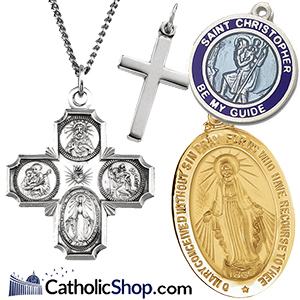 Catholic jewelry and patron saint medals can also be a way to show solidarity with other Catholics. By wearing a crucifix or a patron saint medal, people are identifying themselves as Catholics and expressing their belief in the teachings of the Church. It can also serve as a way to connect with other Catholics and to show support for their faith.
Catholic jewelry and patron saint medals can also be a way to show solidarity with other Catholics. By wearing a crucifix or a patron saint medal, people are identifying themselves as Catholics and expressing their belief in the teachings of the Church. It can also serve as a way to connect with other Catholics and to show support for their faith.
In conclusion, people wear Catholic jewelry and patron saint medals for many different reasons. Whether it is to express faith, seek intercession, find comfort and protection, or show solidarity with other Catholics, these items are powerful symbols of the wearer’s relationship with God and the saints. They serve as a reminder of the love and guidance that God and the saints offer to all people who seek them.



